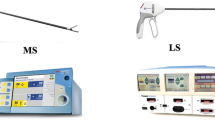Abstract
Purpose
To compare bipolar vessel sealing (BVS; BiClamp®) versus conventional suture ligation in vaginal hysterectomy.
Methods
A multicenter, single-blind randomized controlled trial (RCT) was conducted at eight women’s hospitals in Germany. One hundred and seventy-five patients with benign uterine disease underwent vaginal hysterectomy using BVS (n = 88) or conventional suture ligation (n = 87 controls). Data analysis was based on intention-to-treat.
Results
Postoperative pain (primary endpoint) was decreased in the BVS group, but not significantly. Intraoperative blood loss was significantly lower in this group, with <100 mL recorded in 79/88 versus 52/86 patients (P < 0.001). Hemoglobin decrease indicated non-significantly lower blood loss in the BVS group. Operating time was significantly shorter in the BVS group than in the controls (38.0 ± 18.6 vs. 48.0 ± 24.9 min; P = 0.001). On average, 7.8 sutures/operation were saved with bipolar coagulation (P < 0.0001). Ease of use ratings were significantly higher for BVS. Hospital stay was similar for both groups. Adverse event rates did not differ significantly.
Conclusions
The BiClamp® procedure proved superior or similar to conventional ligation, particularly with regard to intraoperative blood loss, operating time and postoperative pain, although statistical significance was not attained for postoperative pain. Moreover, BVS was easier to use and more cost effective.

Similar content being viewed by others
References
Brill AI (2006) Hysterectomy in the 21st century: different approaches, different challenges. Clin Obstet Gynecol 49:722–735. doi:10.1097/01.grf.0000211946.51712.42
Falcone T, Walters MD (2008) Hysterectomy for benign disease. Obstet Gynecol 111:753–767
Cosson M, Rajabally R, Querleu D, Crepin G (1998) Hysterectomy: indications, surgical routes, cases for adnexal or cervical conservation. Eur J Obstet Gynecol Reprod Biol 80:5–15. doi:10.1016/S0301-2115(97)00240-6
Garry R, Fountain J, Mason S et al (2004) The eVALuate study: two parallel randomised trials, one comparing laparoscopic with abdominal hysterectomy, the other comparing laparoscopic with vaginal hysterectomy. BMJ 328:129. doi:10.1136/bmj.37984.623889.F6
Abdelmonem A, Wilson H, Pasic R (2006) Observational comparison of abdominal, vaginal and laparoscopic hysterectomy as performed at a university teaching hospital. J Reprod Med 51:945–954
Sculpher M, Manca A, Abbott J, Fountain J, Mason S, Garry R (2004) Cost effectiveness analysis of laparoscopic hysterectomy compared with standard hysterectomy: results from a randomised trial. BMJ 328:134. doi:10.1136/bmj.37942.601331.EE
Hach W, Hach-Wunderle V (2004) Die Geschichte der Gefäßligatur: Darstellung anhand der berühmten Froriep’schen Kupfertafeln (1820–1848). Gefasschirurgie 9:220–226. doi:10.1007/s00772-004-0350-7
Mayer A (1952) Ligaturlose Blutstillung bei gynäkologischen Radikaloperationen. Zentralbl Chir 76:1635
McLellan R, Anania C, Birdsall M, Bruno R, Hurd JK, Prakash P (2001) Ligasure versus sutures in total abdominal hysterectomy. Obstet Gynecol 97:S7–S8. doi:10.1016/S0029-7844(01)01146-2
Stapff M (2007) Arzneimittelstudien. Ein Handbuch zur Durchführung von klinischen Prüfungen speziell für Ärzte und medizinisches Assistenzpersonal. W. Zuckschwerdt Verlag, Munich
Wallwiener C, Wallwiener M, Neunhoeffer E, Menger M, Isaacson K, Zubke W (2007) Intelligent, impedance-regulated, pulsed coagulation in a porcine renal artery model. Fertil Steril 88:206–211. doi:10.1016/j.fertnstert.2006.11.204
Wallwiener D, Jonat W, Kreienberg R, Friese K, Diedrich K, Beckmann MW (eds) (2008) Atlas der gynäkologischen Operationen. Thieme Verlag, Stuttgart
Zubke W, Becker S, Krämer B, Wallwiener D (2004) Vaginal hysterectomy: a new approach using bicoagulation forceps. Gynecol Surg 1:179–182. doi:10.1007/s10397-004-0034-z
Douay N, Belot F, Bader G, Guyot B, Heitz D, Fauconnier A (2007) Postoperative pain after hysterectomy through vaginal routes using electro surgical bipolar vessel sealing versus conventional suture ligature. Gynecol Obstet Fertil 35:632–636. doi:10.1016/j.gyobfe.2007.05.015
Cronjé HS, de Coning EC (2005) Electrosurgical bipolar vessel sealing during vaginal hysterectomy. Int J Gynaecol Obstet 91:243–245. doi:10.1016/j.ijgo.2005.08.019
Purohit R, Tripathy P, Pattnaik A (2003) Vaginal hysterectomy using electrocautery and Purohit approach to uterine artery. J Obstet Gynaecol India 53:475–478
Clavé H, Niccolai P (2003) Painless hysterectomy: an innovative technique. J Gynecol Obstet Biol Reprod (Paris) 32:375–380. doi:JGYN-06-2003-32-4-0368-2315-101019-ART11
Clavé H, Baar H, Niccolai P (2005) Painless vaginal hysterectomy with thermal hemostasis (results of a series of 152 cases). Gynecol Surg 2:101–105. doi:10.1007/s10397-005-0112-x
Levy B, Emery L (2003) Randomized trial of suture versus electrosurgical bipolar vessel sealing in vaginal hysterectomy. Obstet Gynecol 102:147–151. doi:10.1016/S0029-7844(03)00405-8
Raaf M, Baase U, Spahn S, Bahlmann F (2005) Die schmerzarme vaginale Hysterektomie mithilfe der BiClamp-Technik: Erste Erfahrungen über 66 Fälle. Zentralbl Gynakol 127:V17
Ding Z, Wable M, Rane A (2005) Use of Ligasure bipolar diathermy system in vaginal hysterectomy. J Obstet Gynaecol 25:49–51. doi:10.1080/01443610400024609
Lobodasch K, Zubke W (2005) Vaginale Hysterektomien mit Hilfe der BiClamp. Geburtshilfe Frauenheilkd 65:1191–1193. doi:10.1055/s-2005-866003
Zubke W, Krämer B, Hornung R, Wallwiener D (2007) Use of the BiClamp (a bipolar coagulation forceps) in gynecological surgery. Gynecol Surg 4:9–16. doi:10.1007/s10397-006-0262-5
Hefni MA, Bhaumik J, El-Toukhy T et al (2005) Safety and efficacy of using the LigaSure vessel sealing system for securing the pedicles in vaginal hysterectomy: randomised controlled trial. BJOG 112:329–333. doi:10.1111/j.1471-0528.2004.00325.x
Brandner P, Neis KJ (2004) Stellenwert der bipolaren Präparation bei der Hysterektomie. Zentralbl Gynakol 126:3_066. doi:10.1055/s-2004-828847
Levy BS, Luciano DE, Emery LL (2005) Outpatient vaginal hysterectomy is safe for patients and reduces institutional cost. J Minim Invasive Gynecol 12:494–501. doi:10.1016/j.jmig.2005.06.015
Penketh R, Griffiths A, Chawathe S (2007) A prospective observational study of the safety and acceptability of vaginal hysterectomy performed in a 24-hour day case surgery setting. BJOG 114:430–436. doi:10.1111/j.1471-0528.2007.01269.x
Lakeman M, Kruitwagen RF, Vos MC, Roovers JP (2008) Electrosurgical bipolar vessel sealing versus conventional clamping and suturing for total abdominal hysterectomy: a randomized trial. J Minim Invasive Gynecol 15:547–553. doi:10.1016/j.jmig.2008.05.011
Acknowledgments
We wish to acknowledge the patients who participated in this study, and our fellow surgeons and hospital staff at the eight participating centers. Funds for trial coordination and monitoring by CenTrial, Tübingen, were kindly provided by ERBE Elektromedizin GmbH, Tübingen, Germany.
Conflict of interest statement
The authors declare that they have no conflict of interest.
Author information
Authors and Affiliations
Corresponding author
Rights and permissions
About this article
Cite this article
Zubke, W., Hornung, R., Wässerer, S. et al. Bipolar coagulation with the BiClamp® forceps versus conventional suture ligation: a multicenter randomized controlled trial in 175 vaginal hysterectomy patients. Arch Gynecol Obstet 280, 753–760 (2009). https://doi.org/10.1007/s00404-009-1010-7
Received:
Accepted:
Published:
Issue Date:
DOI: https://doi.org/10.1007/s00404-009-1010-7




